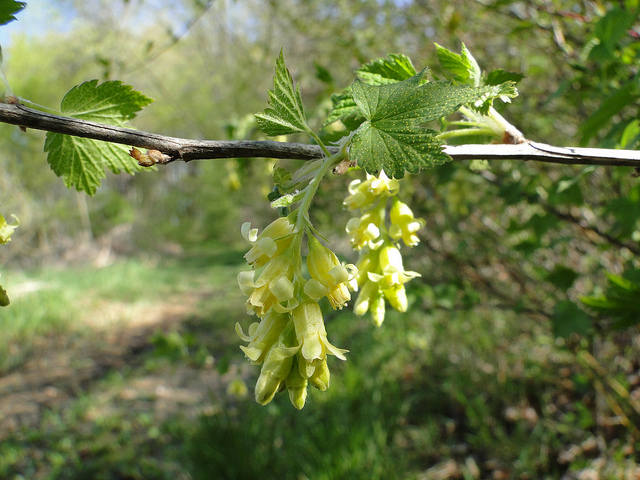Map Snapshot



3 Records
Relationships
Host plant for Clematis Clearwing Moth (Database of the World's Lepidopteran Hostplants).
Seasonality Snapshot
Source: Wikipedia
| Ribes americanum | |
|---|---|

| |
| Scientific classification | |
| Kingdom: | Plantae |
| Clade: | Tracheophytes |
| Clade: | Angiosperms |
| Clade: | Eudicots |
| Order: | Saxifragales |
| Family: | Grossulariaceae |
| Genus: | Ribes |
| Species: | R. americanum
|
| Binomial name | |
| Ribes americanum Mill., 1768
| |
| Synonyms[2] | |
|
List
| |
Ribes americanum is a North American species of flowering plant in the gooseberry family known as wild black currant,[1][3][4][5] American black currant,[6] and eastern black currant.[7] It is widespread in much of Canada (from Alberta to Nova Scotia) and the northern United States (from New England to Washington, with additional populations in Colorado and New Mexico).[8]
Description
[edit]Ribes americanum is a shrub growing 0.5 to 1.5 meters (20-60 inches) in height. The branches are erect and bear deciduous leaves. There are no spines. The plant may form thickets.[9] The glandular leaves are up to 7–8 cm (3–3 in) long and have 3 or 5 lobes. They turn red and gold in the fall.[9][3][10]
The inflorescence is a spreading or drooping raceme of up to 15 flowers. Each flower has reflexed white or greenish sepals a few millimeters long and smaller whitish petals. The fruit is a smooth rounded black berry about a centimeter (0.4 inch) wide and edible when cooked.[3] The plant reproduces mostly by seed.[10]
Distribution and habitat
[edit]This shrub is native to the United States and Canada where grows in a variety of ecosystems. It occurs in many types of forests and in conifer bogs. In Manitoba it can be found in marshes. In the Great Lakes region it grows abundantly in sedge meadows (Carex spp.). Ribes americanum grows on plains and in mountains and sometimes in disturbed areas such as roadsides. It is also shade-tolerant, growing in the understory of closed-canopy woodlands and forests.[10]
It has also been introduced to northern China.[3][11]
Ecology
[edit]Several bee species visit the flowers: Augochlora pura, Augochlorella aurata, Ceratina calcarata, Ceratina dupla, and Ceratina strenua.[4]
This plant is an alternate host for the white pine blister rust (Cronartium ribicola), the vector of a pine tree disease. It is sometimes eradicated in attempts to control the rust.[10]
The cluster cup rust (Puccinia caricina) forms aecia on the leaves of Ribes americanum in the spring, later developing brown blotches of pustules.[4] The telia are formed on sedges (Carex).[4]
Uses
[edit]Native Americans made pemmican from the berries,[12] which are also known for being made into jam and jelly.[10]
References
[edit]- ^ a b NatureServe (2024). "Ribes americanum". Arlington, Virginia. Retrieved 26 September 2024.
- ^ "Ribes americanum Mill". Plants of the World Online. Royal Botanic Gardens, Kew. Retrieved 26 September 2024.
- ^ a b c d Morin, Nancy R. (2009). "Ribes americanum". In Flora of North America Editorial Committee (ed.). Flora of North America North of Mexico (FNA). Vol. 8. New York and Oxford: Oxford University Press. Retrieved January 20, 2012 – via eFloras.org, Missouri Botanical Garden, St. Louis, MO & Harvard University Herbaria, Cambridge, MA.
- ^ a b c d Wilhelm, Gerould; Rericha, Laura (2017). Flora of the Chicago Region: A Floristic and Ecological Synthesis. Indiana Academy of Sciences.
- ^ Reznicek, A. A.; Voss, E. G.; Walters, B. S., eds. (February 2011). "Ribes americanum". Michigan Flora Online. University of Michigan Herbarium. Retrieved 20 August 2020.
- ^ NRCS. "Ribes americanum". PLANTS Database. United States Department of Agriculture (USDA). Retrieved 22 October 2015.
- ^ "Ribes americanum". Go Botany. New England Wildflower Society. Retrieved 20 August 2020.
- ^ "Ribes americanum". County-level distribution map from the North American Plant Atlas (NAPA). Biota of North America Program (BONAP). 2014.
- ^ a b "Ribes americanum" (PDF). USDA NRCS Plant Guide. Retrieved January 20, 2012.
- ^ a b c d e Marshall, K. Anna (1995). "Ribes americanum". Fire Effects Information System (FEIS). US Department of Agriculture (USDA), Forest Service (USFS), Rocky Mountain Research Station, Fire Sciences Laboratory. Retrieved January 20, 2012.
- ^ Lu, Lingdi; Alexander, Crinan. "Ribes americanum". Flora of China – via eFloras.org, Missouri Botanical Garden, St. Louis, MO & Harvard University Herbaria, Cambridge, MA.
- ^ Reiner, Ralph E. (1969). Introducing the Flowering Beauty of Glacier National Park and the Majestic High Rockies. Glacier Park, Inc. p. 124.

